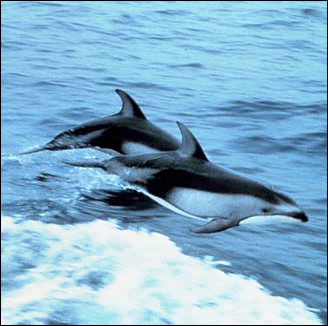Counting dolphins
Problem
If you were a scientist studying dolphins how might you try to estimate how many dolphins were in an ocean?
One way of doing this is to count the number of
Another possible method is to capture dolphins over a period of time, tag them and release them. You can then catch another set of dolphins and see how many of them are tagged. For example, you could catch 100 dolphins from the wild and tag them before releasing them where they were caught. If you then catch another 100 dolphins and find that 5 of them had been tagged you could estimate that
because $\frac{5}{100}$ dolphins in your sample were tagged, 5% of all dolphins had been tagged. You tagged 100 dolphins so if this were true there would be $\frac{100}{0.05}$ = 2000 dolphins in total. What assumptions does this method rely on?
Which of the two methods do you think is better? Is one always better than the other or are there some conditions (eg size of ocean, size of total dolphin population) that might favour the other better? Can you think of any ways to improve these approaches?
Student Solutions
First Approach
This approach is very simple in its conception, and it seems to assume too many things, which make it slightly problematic.
The first problem is that it assumes that dolphins are uniformly distributed throughout the ocean. Factors like food, temperature and predators affect the location where dolphins choose to live. So, in a huge ocean the variation of the sizes of the pods of dolphins is expected to be very large, making the assumption unrealistic.
The second problem is that it only gives us an estimate for the population of dolphins in a very small area of the ocean. Consider, for example, that a medium-sized ocean such as the Indian Ocean contains water of total volume over 290,000 cubic kilometers. So, even if we believe that studying 1% of an area is enough to make deductions about the dolphin distribution, we can see how "insignificant" a result about the number of dolphins in 1000 cubic kilometers is.
And a third problem, is that we can never be sure that we caught all the dolphins within our investigation area.
Second Approach
This approach is slightly more sophisticated, but it still relies on a few assumptions, to which some people might object.
First of all, it assumes that dolphins in general will not travel very far away from the place where they were originally caught. This, however, cannot be taken for granted.
Moreover, what happens if there are 0 tagged dolphins in the second time? The ocean can't have an infinite number of dolphins, so the method cannot provide us with an answer (and so we would need to repeat the experiment until a tagged dolphin gets caught).
Furthermore, if there are too many dolphins in the ocean, we can't know what would be a reasonable number to catch the first time. For example, if there are 50,000 dolphins in an area of the ocean we are looking at, and we only catch 100 at a time, it is highly unlikely that there will be any tagged dolphins in the second set we catch.
